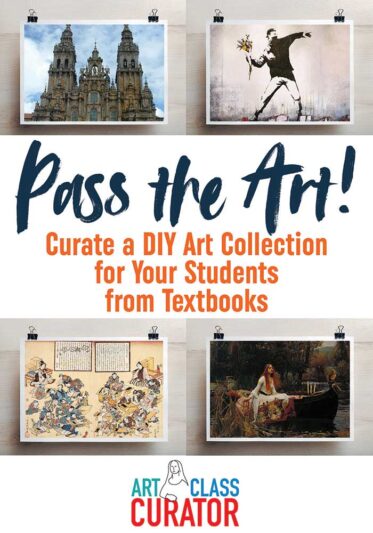Inside: Students, parents, and admins often struggle to understand what we learn from looking at art. Find out some of the many reasons why looking at art is valuable.

Last week, I was teaching a class about German Expressionism, and we were spending a considerable amount of time (over 20 minutes) dissecting and discussing as a class one of my favorite paintings, Franz Marc’s Fate of the Animals. I got a (rather annoying) question from a student. She said:
What are we learning with this? How can this apply to art?
First of all, it’s art, so that second question is instantly voided.
But, the first is a valid question, and while many of us do inherently see the value in looking at and talking about art together, it is not as clear to a lot of people.
Do you have to learn anything for looking at art to be valuable?
Art can be used to teach a lot of things, and that is awesome. Social studies and English have natural connections, and I love using those when I can. I’ve had students say “This is art. Not history. Why are we talking about this?” (Apparently my students have no trouble questioning my teaching methods. *harrumph*). Art is not alone in a vacuum; it is part of the world.
But, art is just as valuable alone as it is when it is used to teach the “core” subjects. So no. Absolutely not. You don’t need to learn anything specific when looking at art.

What do you “learn” when looking at art?
What you learn is not exactly tangible or instantly measurable. So using Franz Marc’s masterpiece as an example, here are the things my students were “learning” this week when discussing Fate of the Animals.
- Focus. By forcing my student to keep looking and keep noticing the elements of the artwork for 20+ minutes, they were learning to focus on what they see. In our world of fast-paced media and short attention spans, this is a useful exercise.
- Higher Order Thinking. Interpreting art allows students to use their brains in more complex ways. When looking at art, students evaluate, analyze, compare, criticize, and construct meaning.
- Empathy. Looking at art helps students understand and better recognize the feelings of others.
- Connection. Looking at art in a group connects you with those you are discussing it with, but looking at art also connects you to the past, to the artist, to the culture, and to anyone else who has also stood before that artwork. It’s a powerful feeling when you step back and look at it that way.
- Respect. Connecting with other cultures and new ideas through art forces students out of their comfort zone and into the world. This process can help them learn to respect things that are different than them.
- Observation and Awareness. Disciplined looking gives students a change to notice details they may not have seen with a quick look. It trains the student to be more aware of the world they are in.
- Understanding Media/Images. This goes along with the last one, but with this world we live in with an abundance of images, our kids need to be trained to recognize the messages those images send.
- Understanding of Self. Art helps us figure out our thoughts and feelings in different ways. It helps us see the world and ourselves in ways that nothing else can. It is not tangible, but it is there.
- Curiosity and Wonder. Art helps foster a sense of wonder and excitement about the world.
Art is valuable. Art is important.
*climbing off my soapbox*
Thanks for listening.
What did I miss? What else do students learn when looking at art? Share your thoughts in the comments!
This post was originally published on April 23, 2015.
Mentioned on the Art Class Curator Podcast…

Free Poster
What Do Kids Learn from Looking at Art Poster
Our students learn so much from looking at art. Use this poster in your classroom to remind them of all the skills they’re growing!





math- spacial, geometry, angles, etc. I’ve only experienced this with DeVinci, but I’m sure it’s in all other art as well.
Oh yes, definitely! MC Escher comes to mind too. 🙂
You are brilliant, Cindy! I have included art appreciation and history in my art instruction for 30 years – I can’t tell you how many times I’ve had kids say something like, “When are we going to do art?” I think that the technology of our present generation is not helping, either!
Thanks for your posts!
Thank you! I have gotten that so many times too! Argh! So frustrating!
Great article! Putting tangible value on art is like putting tangible value on a hug.
Thanks! Love that analogy.
Thank you so much for your wonderful list about learning and looking at art. I am so blessed that my mom took me to art museums starting at 5 yrs old, by 10 I could recognize many famous artist works, and had an education far beyond just learning the facts. You are absolutely spot on with these wonderful descriptions! As an art teacher, currently looking for a new position, I truly appreciate this kind of advocacy. I also volunteer teaching art at a state prison. We just began an art history unit, your list is most helpful to include in my class! Thank you , thank you !
You’re welcome! What an amazing gift your mom gave you. 🙂
Art is SO many things! Many things not tangible- as you put it. I totally agree. Sometimes Art is how we learn just basic life skills like PROCESS, PATIENCE, PRACTICE through trial and error, and just a theraputic release of the energy and imagination within! As an K-5, elementary Art teacher, I sometimes find myself lost in thought under all the intimidating language of teaching with rigor and standarized testing that overwhelm our school- to the point where student volunteers have come in to help in my classroom and say things like, “Oh i like art, but I want to teach in a regular classroom so i can actually ‘form’ minds”.. {insert sucker punch here} Art teaches more than we could ever lecture or produce on paper- and coming across your site and this particular “soapbox” was refreshing for me. Thank you. I look forward to more refreshing goodness as I just subscribed today! 🙂
I’m about to go back to school to get my teaching credential and boy, what I wouldn’t give to be able to teach art for K-5, but sadly it’s not available in public schools in California (at least not in the bay area). Instead, I’ll get a multiple-subject K-8 credential, then later add in the single-subject (art) for high school, and hopefully be able to find a gig teaching art in middle school.
Good luck! I’m LOVING teaching middle school right now. I actually like it much better than when I taught elementary.
I wonder, for example, if you put a 5-12 years old child, in front of an artwork. How does he or she take notes about the piece of art he or she is watching at ? Let’s say, from the point of view of the elements of art. To put it differently, how does a child read or interpret a painting using his or her own words, on the basis of his or her level of knowledge about art ? Is there any technique a child should follow, or a form to simply fill it in.
Great questions! Check out my post How to Look at Art with Toddlers and Preschoolers. I think you’ll find a lot of helpful information there.
Thank you for this post! At my school/ in our district we adopted a literacy program called Wit and Wisdom, which has a stage in each lesson set for the class to view a master work and discuss in some way. The classroom teachers seem excited. I shared your points with the school via email, and some teachers even used these points during last night’s Meet the Teacher!